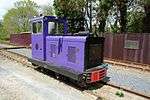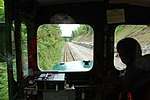Waterford and Suir Valley Railway
The Waterford & Suir Valley Railway (WSVR) is a registered charity operating a 3 ft (914 mm) gauge railway along approximately 10 km of track from Kilmeadan back towards Waterford, Ireland. The line shares much of its route along the banks of River Suir with the Waterford Greenway. This passes through the station which offers parking and a coffee shop with facilities for visitors.
| Waterford and Suir Valley Railway | |
|---|---|
.jpg) For much of its length the line skirts the River Suir. | |
| Locale | County Waterford, Ireland |
| Commercial operations | |
| Built by | Waterford, Dungarvan and Lismore Railway |
| Original gauge | 5 ft 3 in (1,600 mm) |
| Preserved operations | |
| Length | 10 km (6.2 mi) |
| Preserved gauge | 3 ft (914 mm) |
| Commercial history | |
| Opened | 1878 |
| Closed | 1967 |
| Preservation history | |
| 1997 | preservation society founded |
| 2000 | first 3 ft gauge track laid |
| 2003 | first public trains run |
| Website | |
| www | |
Apart from the station platforms there are two other halts, built in 2017, at Mount Congreve and Bilberry on the outskirts of Waterford. The railway uses diesel locomotives. In addition to regular scheduled services, the railway also operates the Spooky Express and Santa Express services. The carriages are wheelchair accessible.
History
The society was established in 1997[1] with the intention of restoring the Waterford and Tramore Railway, but after feasibility studies this was deemed impractical due to changes in road layouts since the line's closure.
The Waterford - Dungarvan rail route was then explored and agreement was reached to try to restore a section of the historic line. The society laid its first track in 2000 and by the end of 2003 it had laid over 8 km of track from Kilmeadan to Gracedieu Junction. It ran its first public trains in May that year.
In 2004, a further 2 km of track were laid as far as Bilberry. In 2008, the railway carried its 100,000th passenger, and in 2010 opened a maintenance and storage shed for its rolling stock. In 2016, the WSVR received planning permission for a new station building at Kilmeadan for which it is seeking to raise funds.
In March 2017 the Waterford Greenway opened on the 46 km of track bed built for the Waterford to Dungarvan rail line with walkers and cyclists sharing much of the last 10 km with the heritage railway as it heads towards Waterford City. Kilmeaden station is a meeting point with users of the Greenway and visitors to the railway availing of the station's facilities.
The railway is a registered charity operated by over 50 volunteers with the purpose of preserving a part of Waterford's significant industrial heritage and educating visitors on its rich history. In 2016 the railway carried over 24,000 passengers and by 2018 this number had risen to just under 30,000.
Route
The entire route is on the trackbed of the former 5 ft 3 in (1,600 mm) gauge Waterford, Dungarvan & Lismore Railway, which was opened in 1878[2] and closed in 1967, though a section remained open until 1987 for magnesite ore processing at the Quigley plant in Ballinacourty. This plant closed in 1982 though occasional weed spraying trains ran on the line up until May 1990. The WSVR uses the original railway station at Kilmeadan.
The Dan Donovan Tunnel under the Waterford Bypass specifically built to facilitate the line running towards Waterford City.
Though the line extends as far as a new platform at Bilberry just to the east of Waterford City, scheduled trains mostly run as far as Gracedieu Junction before turning back. Some pre-booked trains run the full length of the line to accommodate groups arriving by coach at the Bilberry coach and car park. Apart from the passing loop in Kilmeaden, the line is single track for the length of the route.
Future development
New platforms have already been completed along the line at Mount Congreve Gardens and Bilberry where the local council has also created a coach parking area. Further halts are planned for the Woodstown Viking site and Waterford Institute of Technology Carriganore Campus. The new coffee shop and facilities are nearing completion, partly funded by the Dormant Accounts Fund, which will help meet the needs of the growing number of visitors to the railway and the Greenway.
It is the hope of the Board and the volunteers to return steam to the line at some point with efforts underway to source a suitable locomotive for restoration as funds become available.
Rolling stock
Rolling stock consists of three diesel locomotives and two purpose-built semi-open bogie passenger carriages.[3][4] A number of permanent way wagons are kept inside the shed at Kilmaedan.
At Kilmeadan Station, an ex-Irish Rail grounded MkII carriage, No. 4106, is used as a ticket office and refreshment room.[5]
Volunteers
The railway is operated by over 50 trained volunteers of differing ages and interests who give freely of their time on a regular basis. Their skills and commitment are essential to the running and maintenance of the trains assisted by a smaller number of paid staff.
Gallery
.jpg) Mount Congeve Gardens halt
Mount Congeve Gardens halt Hunslet locomotive
Hunslet locomotive View towards Kilmeaden
View towards Kilmeaden Leaving the station
Leaving the station.jpg) Heading towards Waterford City
Heading towards Waterford City
References
- Brown, Jonathan (2017). The Railway Preservation Revolution: A History of Britain's Heritage Railways (E-book). Pen & Sword Books. p. n.p. ISBN 9781473891197 – via Google Books.
- Albertson, Elizabeth (2011). Ireland For Dummies (E-book). Wiley. p. 215. ISBN 9781118028223 – via Google Books.
- "Semi-Open bogie carriage". Vintage Carriages Trust. Retrieved 6 June 2017.
- "Semi-Open bogie carriage". Vintage Carriages Trust. Retrieved 6 June 2017.
- "BR 3157 Mk 2c First Open (body only) built 1970". Vintage Carriages Trust. Retrieved 6 June 2017.
External links
| Wikimedia Commons has media related to Waterford and Suir Valley Railway. |